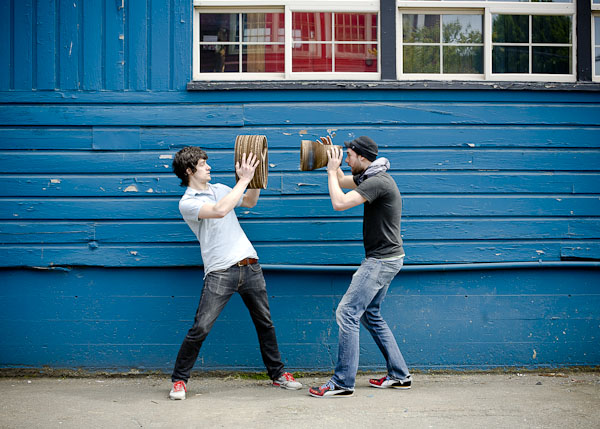The renowned design firm began with two college grads and a chair competition.
We’re all aware that the market crash has left our economy in a sorry state. With many stalled building projects, a trickle-down effect has been created for banks, real estate agents, building contractors and architects. This lack of work has resulted in — among other things — lots of free time.

Architects Jonathan Junker and Seth Grizzle were unfazed by the trying times. This duo used their new-found free time to consider the creative possibilities, rather than lament the slowly recovering market as a “setback.” Their recession project, graypants, inc., has evolved into one of the most innovative, highly-respected interior design studios in the country.
Junker and Grizzle met during their first year in an architecture design studio at Kent State University; incidentally, both men happened to own the same pair of gray pants. Eventually, the two friends settled in Seattle. When they founded a design firm in January 2008, their shared article of clothing inspired their brand name.
The following month, graypants (yes, the small ‘g’ is on purpose) entered “Take a Seat,” a sustainable chair design competition. For the contest, Junker and Grizzle opted to “dumpster dive,” hoping to find a chair that had been discarded and then transform it into something useful. They started out with four chairs made from old newspapers, discarded corrugated cardboard, used freight container slip-sheet lining and pieces of plywood, respectively. The scraps from these chairs evolved into their current signature product: lights made from cardboard.
Grizzle credits an art teacher for his deeply-instilled love of architecture. He designed his first dream home in middle school and his long-term goal from that point onward was to someday work for an architect firm – as well as design furniture, on the side. Junker, on the other hand, wanted to be a graphic designer. He was also inspired by a teacher – his high school drafting instructor. In the end, Junker’s goal was the same as Grizzle’s – to one day design buildings.
“We all remember that one person who made a difference in our life,” Grizzle said. “The one who believed in us and helped us think differently about the world.”
Today, the pair designs lights made of anything from corrugated cardboard to discarded ping-pong balls. The words ‘big,’ ‘small,’ ‘dangling,’ ‘stationary,’ ‘compact’ and ‘behemoth’ could all be used to describe different graypants models. In short, anything you could imagine. “[graypants projects are] pushing the bounds of creativity on many levels,” Grizzle said.
Junker explained that, while many companies approach design from a very pragmatic standpoint, the graypants team thrives on thinking outside the box.
“The creative approach allows a creative idea,” Junker explained. “People are hesitant to throw out an idea, [but at graypants] we are the opposite. We throw stuff out there and don’t worry about it. The more you promote your ideas, the more ideas are shared. We don’t limit the scope of what we do.”
“That (type of thinking) doesn’t stop us from having crazy thoughts,” he added, “but instead have a different perspective. It’s a higher value thinking component.”
In terms of the atmosphere, Grizzle and Junker describe their proverbial door as always open to new talent. If someone wants to work there just to be inspired, they are welcome to it. Both men believe you will only learn more by surrounding yourself with creative energy and collaborative spirit.
The founders of graypants are also eco-conscious, taking environmentalism a step further than the typical West Coast native. Since neither one has a car, they rely on public transit and Zip cars. A few years ago, residents of Capitol Hill might have noticed them boarding a bus with sheets of cardboard and scrap light prototypes.
[nggallery id=40]
The pair started out without a shop. Instead, they used a two-bedroom apartment for their workspace. In order to fabricate chairs, the guys turned one bathroom into what they call “a bubble”. The inside walls were lined with plastic sheathing, which allowed them to contain debris with a skill saw. They recalled exiting their 30-square-foot “shop” covered in sawdust because there was nowhere for it to go but all over them.
The business was initially housed in a studio with narrow hallways and no loading dock. This confined graypants to using items that could be carried through a door or dismantled. Their new home in Sodo, however — a former shipbuilding warehouse — has high ceilings, lots of natural light and, yes, a loading dock.
These days, graypants is getting serious attention, as Starbucks, Nordstrom and several restaurants in Chicago have all enlisted in their services. In addition, Grizzle and Junker will soon launch a new series of chairs, using a material that allows one sheet of plywood to yield three chairs. Both men have several upcoming architectural projects, as well.
You can be sure that whatever the market does and however our economy fares, Seth Grizzle and Jon Junker will boldly consider what they can do to survive sustainably.
graypants, inc. | 3220 1st Ave. S., #400, Seattle | (206) 420-3912
